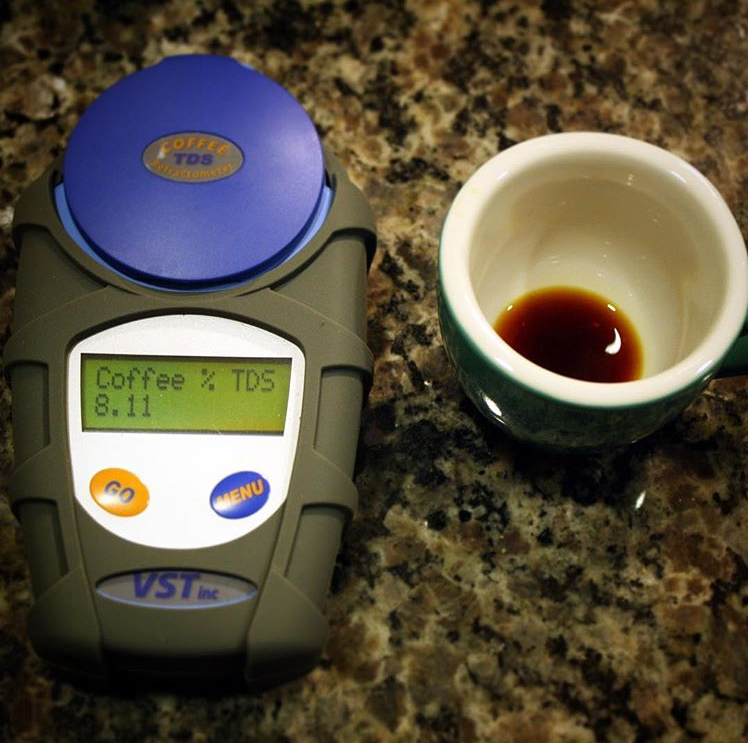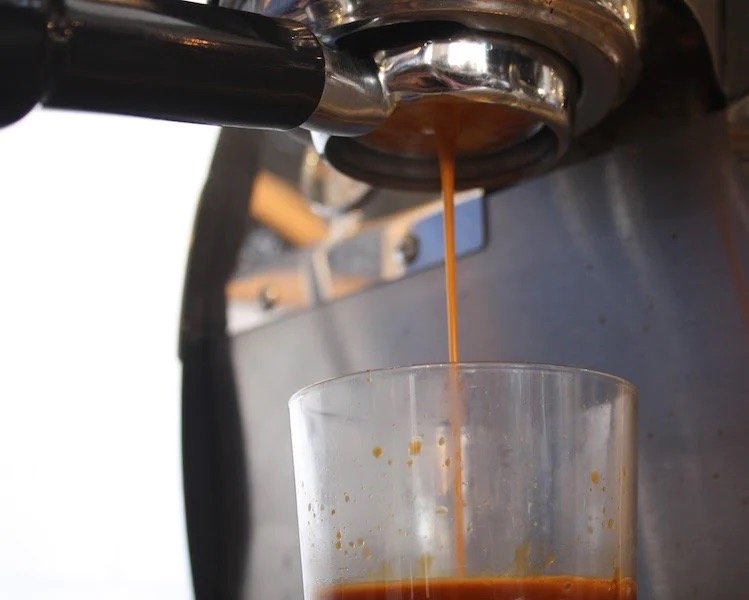Espresso 101
It is perhaps the most difficult and most misunderstood method of turning ground coffee into a delicious liquid. Historically, a single espresso shot was 7 grams of ground coffee producing 25 milliliters of liquid espresso in 25 seconds with very darkly roasted, low quality coffee beans. At best, this would give a rich, chocolatey flavor, but generally just tasted very bitter and smoky. Most espresso drinkers added sugar and/or milk to cut down on the bitterness.
The Ristretto Era
In an attempt to cut down on the bitterness without adding milk/sugar, ristrettos became popular in the 1990s. A ristretto is defined as a 1:1 ratio (or smaller) of liquid espresso in the cup to dry coffee dose. The less water is used per unit coffee, the less flavor is extracted. When flavor is being extracted from coffee grounds, acids are extracted first, then sugars, then bitter/smoky (depending on roast level) flavors, so, reducing the amount of water per unit coffee shifts the flavor balance more towards sweet and/or acidic, so this did indeed reduce the smoky bitterness.
However, since everyone was used to 25 mL being the standard "size" for espresso, the dry coffee dose was increased from 7 grams to 20 grams (or more). Hello, caffeine! And hello, inefficient use of coffee (goodbye, money)!
The SCA Standard
Although our ristrettos were no longer intensely bitter, they had also lost most of their sweetness, and, when not done well, introduced a bizarrely salty flavor to the shots. The Specialty Coffee Association unveiled its own standard for espresso - a 2:1 ratio of liquid espresso in the cup to dry coffee grounds, achieved in about 25 seconds. It's identical to the traditional Italian recipe except the ratio is 2:1 instead of 3:1, which means we are going to have less extraction, and less bitterness. Some of the sweetness that was lost in the ristretto era came back, and some of the saltiness disappeared.
The Scientists Got Involved
A device called a refractometer was introduced to specialty coffee. This device measures the concentration of dissolved solids in coffee (or espresso). When that number is multiplied by the brew ratio (1:1 ratio of liquid espresso to dry coffee grounds for a ristretto, 2:1 ratio for "normale" espresso, and 3:1 ratio for "lungo"), it gives you the extraction yield of the beverage. For example, if the total dissolved solids percentage (TDS%) of a 1:1 ristretto shot was 13%, then 13% of the coffee grounds were extracted. Another example, a TDS% of 9.5% in a 2:1 espresso shot would be an extraction yield of 19%.
We've known for years that, roughly speaking, an extraction yield of 18-22% tastes good. The techies realized that these 13% extraction ristrettos were woefully underextracted (common flavors associated with underextraction are sour, vegetal, salty, and nutty) and only tasted decent because the roasting was so dark. The 19ish% extraction that was achievable with a normale 2:1 ratio shot generally tasted much better, especially with a medium roast coffee. Interestingly, it isn't really possible with our current grinder and espresso machine technology to achieve higher than 19-20% extraction at a 2:1 ratio. That said, if you want a rich, chocolate-y espresso with low acidity and some mild fruit sweetness, a good quality medium roast coffee at a 2:1 ratio is a good starting point for a recipe.
Our Good Vibes blend does well with this recipe with a shot time of roughly 25 seconds. The SCA Standard works!
Modern Espresso
Since humans are wonderful and never satisfied with the status quo, we pushed onwards. The higher we can get the extraction yield (without introducing astringency/bitterness/dryness), the more sweetness we will get, and the more of the character of the coffee we will taste. If drip coffee can taste great at 22% extraction, how can we make espresso do the same? The answer was to roast coffee lighter (basically, use coffee that was roasted with a drip/pourover profile instead of an espresso profile) and increase brew ratio to 3:1 ("lungo") or even further. Now, a typical shot with one of our Bright & Striking single origin coffees might be a TDS% of 7% with an extraction yield of 21%. Some coffees (particularly Kenyans) shine at 4:1 brew ratios with TDS% of 5.75%, for an extraction yield of 23%. Since the TDS% is lower, these shots are slightly less syrupy than traditional shots, but more than make up for that with their outstanding flavor.
Yes, we can now make coffee taste good at extraction yields beyond the 22% limit that has been the standard for dozens of years. It requires a very good grinder and seemingly outrageous shot times (40 seconds. 50 seconds. 60 seconds even). These shots taste just like the best pourover you've ever had, sweet, fruity, and full of character and complexity. Our favorite coffees for these type of shots are Ethiopians like this past season's Idido Organic (our 2019 Good Food Awards Finalist), our past season's Kenya Gatomboya AA, and/or something funky and wild like our past season's Ethiopia Bale Mountain natural process.
Got any questions about espresso? Shoot us an email, we're more than happy to answer them. Or even better, ask us about our private espresso classes!




